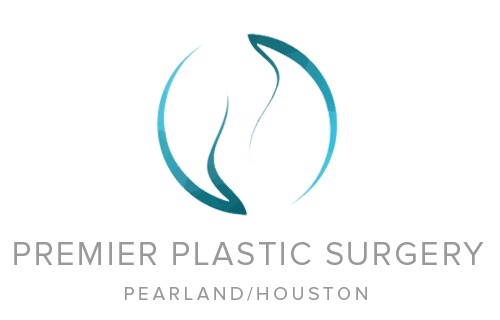
Fat Transfer and Injections in Houston, TX
Premier Plastic Surgery is a state-of-the-art medical spa for surgical as well as non-surgical treatments to restore and rejuvenate your body and skin. One of the services we offer is fat transfer and injections. By using your own body fat to plump up certain areas, the risk of rejection is virtually zero. Dr. Hankins provides fat grafting services to men and women in Houston, Pearland, Lake Jackson, and the surrounding areas of South Houston.
What Are Fat Transfers and Injections?
The basic premise of a fat transfer is to take fat from one part of your body where there is typically excess, such as your outer thigh or your stomach, and transfer and inject it to another area of your body that needs plumping up, such as the face or the buttocks.
The cosmetic surgery procedure is sometimes called fat grafting or fat injection. It’s also known as microlipoinjection and autologous (coming from the same organism) fat injections. It’s a safe, well-tolerated procedure with proven long-lasting, natural-looking results.
Fat Transfer Benefits
Most patients are immensely satisfied with the results of their fat grafting procedure.
- Long-lasting, natural-looking results
- Chances of rejection or allergic reaction are reduced by using your own body tissue
- Increased volume in an area that needs it while losing fat in an area that doesn’t need it
- No general anesthesia needed
Fat Transfer Procedure
During the fat transfer procedure, our plastic surgeon, Dr. Hankins, will first use general or local anesthesia to ensure your comfort. From there, excess fat is removed from one or more areas of the body (often using liposuction), purified, and then the transferred fat cells are injected into the areas of the body or face you’re looking to enhance or plump. The number of fat injections used depends on the results you’re looking for.
Fat Transfer Recovery
The fat transfer procedure is typically an outpatient procedure, so you can go home on the day of treatment. You will likely see some swelling and bruising, but those side effects will subside on their own.
That said, you will need someone to drive you home. You’ll want to rest for the first few days and then you should be able to return to work after that, as long as your work isn’t too strenuous or involves heavy lifting.
You may see some results immediately, but most of the results won’t appear until the swelling goes down and the transferred fat tissue develops its own blood supply. It usually takes a few months before you see the final results.
Fat Transfer and Injections Quick Facts
- Type of Injection: Filler
- Length of Treatment: Approximately two hours (varies)
- Anesthesia: Local
- Recovery: Special care is required for two weeks post-treatment
- Expected Results: Visible when swelling subsides
- Longevity of Results: Up to two years
Frequently Asked Questions about Fat Transfer
What is the fat transfer success rate?
Success rates of fat transfer have historically been low, but continued research and development have improved fat transfer success rates. However, the success is ultimately variable from patient to patient, ranging anywhere from 50% to 80%. In our practice, the retention rates have been 80% are better, but it is important to realize that results vary from patient to patient.
How long will fat transfer results take?
You will see results right away, with permanent results appearing in 6 months or less.
Is fat transfer painful?
Fat transfers are minimally invasive procedures that do not involve a lot of pain. Mostly, patients will notice a soreness as their body heals.
Will fat transfer results disappear if I lose weight?
Fat transfers are meant to last a lifetime for patients within their target weight range, but patients who continue to fluctuate in weight after their operation may see their results vary with their weight fluctuations. This because the transplanted fat cells will behave according to their site of origin, not like the fat of the recipient site.
Should I lose weight before a fat transfer?
You should be at your ideal target weight before undergoing the procedure. Weight fluctuations can negatively impact your results, so patients’ ability to maintain a stable weight is crucial.
What weight is ideal for a fat transfer?
Those patients with a normal to slightly overweight BMI are ideal patients for the procedure.
Can I choose where my fat is harvested?
Yes.
Are you awake during a fat transfer?
Yes and no. Small procedures can be done with local or tumescent anesthesia only, whereas larger procedures may require Iv sedation.
Are implants or fat transfers better?
There are pros and cons of each procedure. The upside of fat grafts is that once taken, the results are permanent. The downside is that in some cases, more than one fat grafting session may be necessary to obtain the optimum results. Implants are both permanent and reversible. However, implants, depending on the type, can degrade with the passage to time, degrade and result in atrophy of adjacent soft tissue or bone.
If you’re wondering if a fat transfer is right for you, don’t hesitate to contact the office and set up a free, personal consultation. You’ll be able to have all your questions answered and your concerns addressed before you even need to make a decision. Dr. Hankins will help you determine if fat grafting is the right choice for you to help you achieve the look you desire. We serve residents of Houston, Pearland, Lake Jackson and the surrounding communities of South Houston.
Fat Transfer and Injections in Houston, TX
Premier Plastic Surgery is a state-of-the-art medical spa for surgical as well as non-surgical treatments to restore and rejuvenate your body and skin. One of the services we offer is fat transfer and injections. By using your own body fat to plump up certain areas, the risk of rejection is virtually zero. Dr. Hankins provides fat grafting services to men and women in Houston, Pearland, Lake Jackson, and the surrounding areas of South Houston.
What Are Fat Transfers and Injections?
The basic premise of a fat transfer is to take fat from one part of your body where there is typically excess, such as your outer thigh or your stomach, and transfer and inject it to another area of your body that needs plumping up, such as the face or the buttocks.
The cosmetic surgery procedure is sometimes called fat grafting or fat injection. It’s also known as microlipoinjection and autologous (coming from the same organism) fat injections. It’s a safe, well-tolerated procedure with proven long-lasting, natural-looking results.
Fat Transfer Benefits
Most patients are immensely satisfied with the results of their fat grafting procedure.
- Long-lasting, natural-looking results
- Chances of rejection or allergic reaction are reduced by using your own body tissue
- Increased volume in an area that needs it while losing fat in an area that doesn’t need it
- No general anesthesia needed
Fat Transfer Procedure
During the fat transfer procedure, our plastic surgeon, Dr. Hankins, will first use general or local anesthesia to ensure your comfort. From there, excess fat is removed from one or more areas of the body (often using liposuction), purified, and then the transferred fat cells are injected into the areas of the body or face you’re looking to enhance or plump. The number of fat injections used depends on the results you’re looking for.
Fat Transfer Recovery
The fat transfer procedure is typically an outpatient procedure, so you can go home on the day of treatment. You will likely see some swelling and bruising, but those side effects will subside on their own.
That said, you will need someone to drive you home. You’ll want to rest for the first few days and then you should be able to return to work after that, as long as your work isn’t too strenuous or involves heavy lifting.
You may see some results immediately, but most of the results won’t appear until the swelling goes down and the transferred fat tissue develops its own blood supply. It usually takes a few months before you see the final results.
Fat Transfer and Injections Quick Facts
- Type of Injection: Filler
- Length of Treatment: Approximately two hours (varies)
- Anesthesia: Local
- Recovery: Special care is required for two weeks post-treatment
- Expected Results: Visible when swelling subsides
- Longevity of Results: Up to two years
Frequently Asked Questions about Fat Transfer
What is the fat transfer success rate?
Success rates of fat transfer have historically been low, but continued research and development have improved fat transfer success rates. However, the success is ultimately variable from patient to patient, ranging anywhere from 50% to 80%. In our practice, the retention rates have been 80% are better, but it is important to realize that results vary from patient to patient.
How long will fat transfer results take?
You will see results right away, with permanent results appearing in 6 months or less.
Is fat transfer painful?
Fat transfers are minimally invasive procedures that do not involve a lot of pain. Mostly, patients will notice a soreness as their body heals.
Will fat transfer results disappear if I lose weight?
Fat transfers are meant to last a lifetime for patients within their target weight range, but patients who continue to fluctuate in weight after their operation may see their results vary with their weight fluctuations. This because the transplanted fat cells will behave according to their site of origin, not like the fat of the recipient site.
Should I lose weight before a fat transfer?
You should be at your ideal target weight before undergoing the procedure. Weight fluctuations can negatively impact your results, so patients’ ability to maintain a stable weight is crucial.
What weight is ideal for a fat transfer?
Those patients with a normal to slightly overweight BMI are ideal patients for the procedure.
Can I choose where my fat is harvested?
Yes.
Are you awake during a fat transfer?
Yes and no. Small procedures can be done with local or tumescent anesthesia only, whereas larger procedures may require Iv sedation.
Are implants or fat transfers better?
There are pros and cons of each procedure. The upside of fat grafts is that once taken, the results are permanent. The downside is that in some cases, more than one fat grafting session may be necessary to obtain the optimum results. Implants are both permanent and reversible. However, implants, depending on the type, can degrade with the passage to time, degrade and result in atrophy of adjacent soft tissue or bone.
If you’re wondering if a fat transfer is right for you, don’t hesitate to contact the office and set up a free, personal consultation. You’ll be able to have all your questions answered and your concerns addressed before you even need to make a decision. Dr. Hankins will help you determine if fat grafting is the right choice for you to help you achieve the look you desire. We serve residents of Houston, Pearland, Lake Jackson and the surrounding communities of South Houston.
















